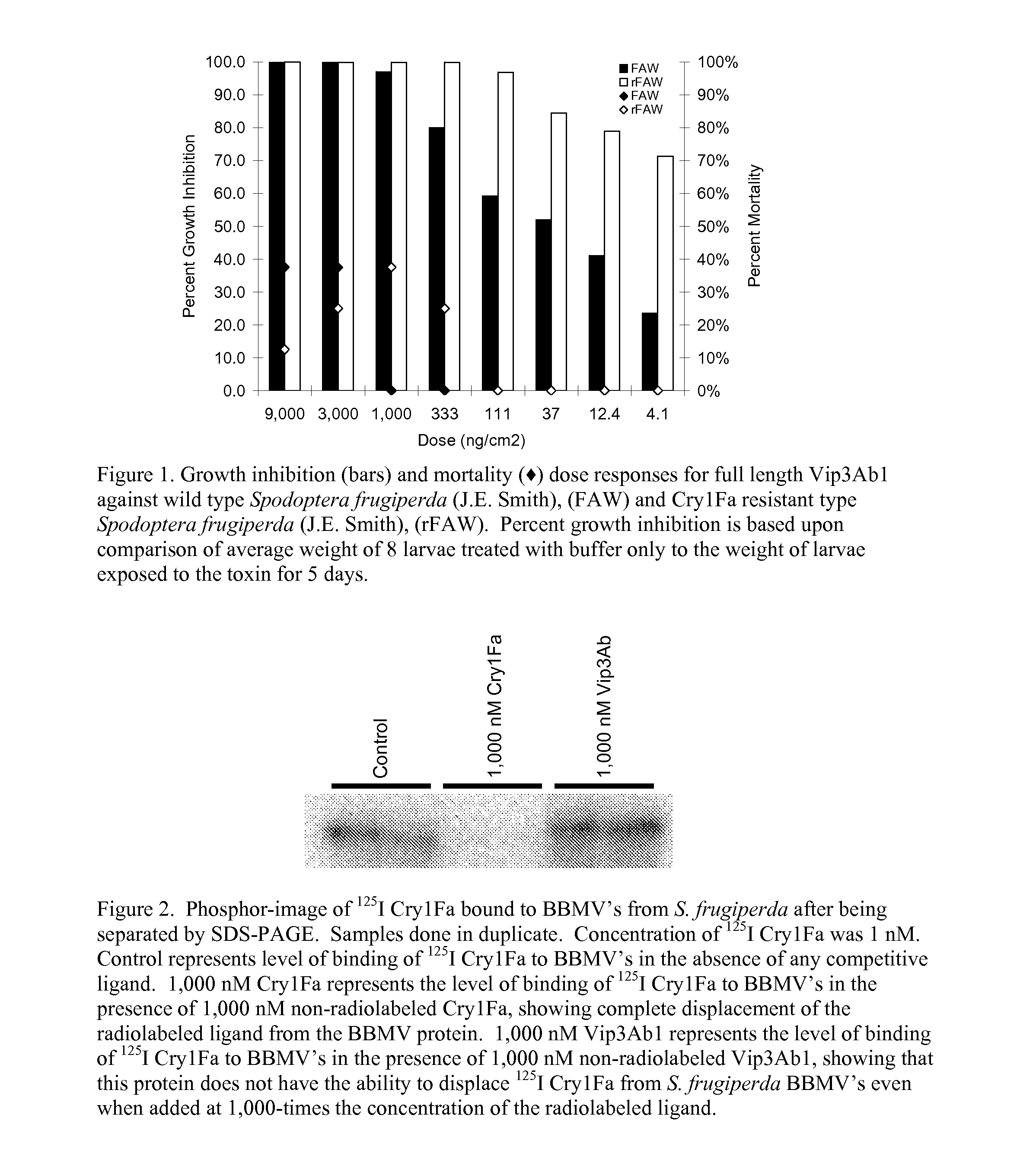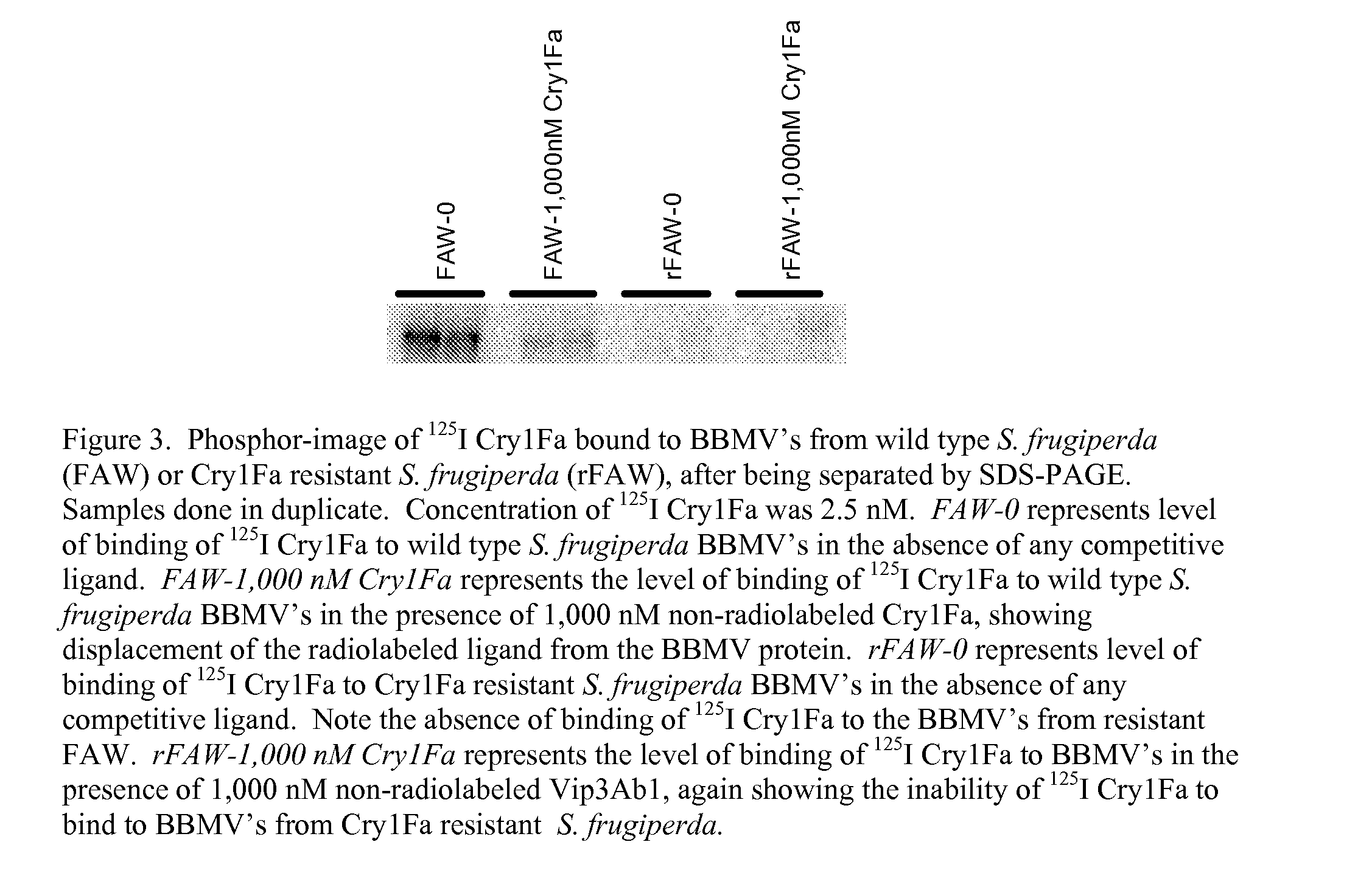Combined use of vip3ab and cry1fa for management of resistant insects
- Summary
- Abstract
- Description
- Claims
- Application Information
AI Technical Summary
Benefits of technology
Problems solved by technology
Method used
Image
Examples
example 1
Summary of Examples
[0105]Examples are given showing that Vip3Ab1 is active against Spodoptera frugiperda (fall armyworm) wild type larvae, and against a field collected strain of Spodoptera frugiperda found in Puerto Rico that is resistant to the Bacillus thuringiensis crystal toxin Cry1Fa. This biological data supports the utility of Vip3Ab1 to be used to combat the development of Cry1 resistance in insects, since insects developing resistance to the Cry1Fa toxins would continue to be susceptible to the toxicity of Vip3Ab1.
[0106]Similarly, in Spodoptera frugiperda, 125I radiolabeled Cry1Fa binds to receptor proteins and the binding can be displaced using non-radiolabeled Cry1Fa. However, Vip3Ab1 cannot displace the binding of 125I Cry1Fa from its receptor in these experiments. These results indicate that Vip3Ab1 has a unique binding site as compared to Cry1Fa. The ability of Vip3Ab1 to exert toxicity against insects that are resistant to Cry1Fa stems from its demonstrated non-inter...
example 2
Purification and Trypsin Processing of Cry1Fa and Vip3Ab1 Proteins
[0107]The genes encoding the Cry1Fa and Vip3Ab1 pro toxins were expressed in Pseudomonas fluorescens expression strains and the full length proteins isolated as insoluble inclusion bodies. The washed inclusion bodies were solubilized by stirring at 37° C. in buffer containing 20 mM CAPS buffer, pH 11, +10 mM DDT, +0.1% 2-mercaptoethanol, for 2 hrs. The solution was centrifuged at 27,000×g for 10 min. at 37° C. and the supernatant treated with 0.5% (w / v) TCPK treated trypsin (Sigma). This solution was incubated with mixing for an additional 1 hr. at room temperature, filtered, then loaded onto a Pharmacia Mono Q 1010 column equilibrated with 20 mM CAPS pH 10.5. After washing the loaded column with 2 column volumes of buffer, the truncated toxin was eluted using a linear gradient of 0 to 0.5 M NaCl in 20 mM CAPS in 15 column volumes at a flow rate of 1.0 ml / min. Purified trypsin truncated Cry proteins eluted at about 0....
example 3
Insect Bioassays
[0109]Purified proteins were tested for insecticidal activity in bioassays conducted with neonate Spodoptera frugiperda (J. E. Smith) larvae on artificial insect diet. The Cry1F-resistant FAW were collected from fields of Herculex I (Cry1Fa) corn in Puerto Rico, and brought into the Dow AgroSciences Insectary for continuous rearing. Characterization of this strain of resistant-FAW is outlined in the internal report by Schlenz, et al (Schlenz et al., 2008).
[0110]Insect bioassays were conducted in 128-well plastic bioassay trays (C-D International, Pitman, N.J.). Each well contained 0.5 mL of multi-species lepidoptera diet (Southland Products, Lake Village, Ark.). A 40 μL aliquot of the purified Cry or Vip3Ab1 protein diluted to various concentrations in 10 mM CAPS, pH 10.5, or control solution was delivered by pipette onto the 1.5 cm2 diet surface of each well (26.7 μL / cm2). Sixteen wells were tested per sample. The negative control was a buffer solution blank contain...
PUM
| Property | Measurement | Unit |
|---|---|---|
| Fraction | aaaaa | aaaaa |
| Fraction | aaaaa | aaaaa |
| Fraction | aaaaa | aaaaa |
Abstract
Description
Claims
Application Information
 Login to View More
Login to View More - R&D
- Intellectual Property
- Life Sciences
- Materials
- Tech Scout
- Unparalleled Data Quality
- Higher Quality Content
- 60% Fewer Hallucinations
Browse by: Latest US Patents, China's latest patents, Technical Efficacy Thesaurus, Application Domain, Technology Topic, Popular Technical Reports.
© 2025 PatSnap. All rights reserved.Legal|Privacy policy|Modern Slavery Act Transparency Statement|Sitemap|About US| Contact US: help@patsnap.com


